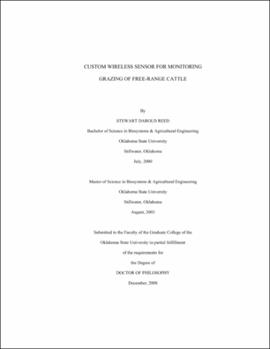| dc.contributor.advisor | Solie, John B. | |
| dc.contributor.author | Reed, Stewart | |
| dc.date.accessioned | 2013-11-26T07:43:15Z | |
| dc.date.available | 2013-11-26T07:43:15Z | |
| dc.date.issued | 2008-12 | |
| dc.identifier.uri | https://hdl.handle.net/11244/6421 | |
| dc.description.abstract | Scope and Method of Study: The purpose of this study was to develop a wireless sensor device capable of sensing cattle grazing activity. This included design and build of a miniaturized PCB, sensor specification, data processing, and experimental validation. Experiments were conducted in cooperation with the Oklahoma State University, Animal Science and Biosystems Engineering departments. The primary objective of this study was to provide information supporting the use of an accelerometer sensor for monitoring free-range cattle grazing activity. A wireless sensor platform was also developed for sensor and wireless communication development needs. Secondary objectives included exploring alternative applications, such as monitoring cattle waste excretion events, and identifying wireless network functionality for agricultural environments. | |
| dc.description.abstract | Findings and Conclusions: During this study, parameters for using an accelerometer based grazing sensor were established relative to the head motion of grazing cattle. Initially, a survey of literature and video analysis of foraging livestock animals were conducted, where 0.5-8 bites/sec was confirmed as animal bite rate range. The preliminary video analysis provided guidelines for establishing a sensing strategy. Sensor data processing algorithm development and sampling rate selection were driven by video provided characteristics and sensor platform capability. The Fast Fourier Transform (FFT) was selected as the core component of the sensor's algorithm. The FFT was able to characterize grazing motions because of the animal's near-continuous periodic head movements. At least five bite cycles and a 32 Hz sampling rate were required for proper algorithm implementation. A sample size of 256 data points were collected for each accelerometer axis, and proved to be adequate for the FFT computations. A revised sample rate of 21.74 Hz was presented once the FFT was implemented in firmware. This new rate retained well performing FFT calculations based on the understanding that bite rates faster than 4 bites/sec were due to nibbling and partial bites. The FFT's Spectral power was binned and stored for the purpose of data compression and reduced wireless transmissions. | |
| dc.description.abstract | The wireless sensor device platform was built using the CC1010 microcontroller/transceiver IC. The CC1010 provided integrated features commendable for fast FFT processing and conservative PCB layout design. The radio was configured for robust operation by using a 915 MHz carrier frequency, Manchester encoding, and 64 kHz frequency spread. A small, helical, and omnidirectional antenna was mounted directly to the PCB. Link budget was estimated to be 81 dBm, which equated to a 282 m (925 ft) transmission distance in optimum conditions. The device's dimensions were 19.6 mm (0.77 in) X 71.8 mm (2.83 in) X 11.0 mm (0.43 in). A custom PVC enclosure was used to house the device. For deploying experiments, the enclosure was fastened to a standard nylon turnout halter. A miniature GPS logger was also attached to the halter, which allowed for constructing grazing maps. | |
| dc.description.abstract | Additionally, the proposed wireless sensor device was used to detect cattle urination and defecation events. This was accomplished by attaching the device to an animal's tail and sensing its elevated movements. Tilt measurements in the z-axis (front-to-back) direction provided the most prominent evidence of a distinct tail movement pattern during excretion events. A pattern recognition strategy was shown as a viable sensing method. | |
| dc.description.abstract | An outline for a multilevel-networked system was also generated. This included cellular and internet communications, along with a customized application software for base/node management. | |
| dc.format | application/pdf | |
| dc.language | en_US | |
| dc.rights | Copyright is held by the author who has granted the Oklahoma State University Library the non-exclusive right to share this material in its institutional repository. Contact Digital Library Services at lib-dls@okstate.edu or 405-744-9161 for the permission policy on the use, reproduction or distribution of this material. | |
| dc.title | Custom wireless sensor for monitoring grazing of free-range cattle | |
| dc.contributor.committeeMember | Stone, Marvin L. | |
| dc.contributor.committeeMember | Wang, Ning | |
| dc.contributor.committeeMember | Raun, William | |
| osu.filename | Reed_okstate_0664D_10091 | |
| osu.accesstype | Open Access | |
| dc.type.genre | Dissertation | |
| dc.type.material | Text | |
| dc.subject.keywords | advanced agriculture | |
| dc.subject.keywords | forage uptake | |
| dc.subject.keywords | grazing sensors | |
| dc.subject.keywords | mobile sensor platform | |
| dc.subject.keywords | precision ranching | |
| dc.subject.keywords | wireless sensor | |
| thesis.degree.discipline | Biosystems and Agricultural Engineering | |
| thesis.degree.grantor | Oklahoma State University | |
